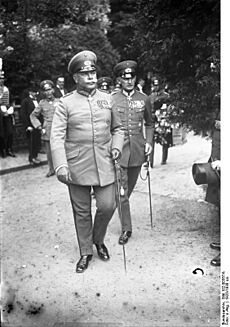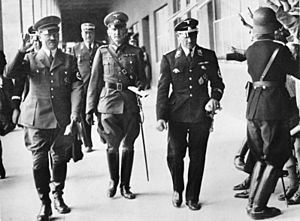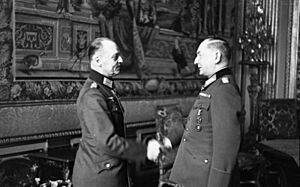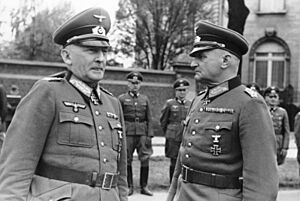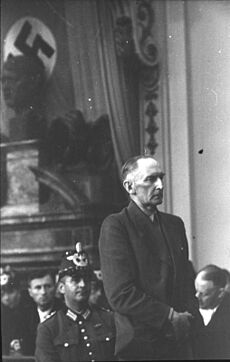Erwin von Witzleben facts for kids
Quick facts for kids
Erwin von Witzleben
|
|
|---|---|
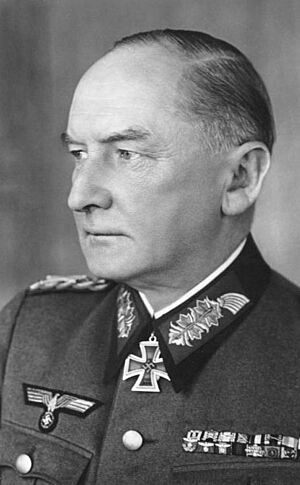
Field Marshal von Witzleben in 1940 or 1941
|
|
| Born | 4 December 1881 Breslau, Province of Silesia, Kingdom of Prussia, German Empire (present-day Wrocław, Lower Silesian Voivodeship, Poland) |
| Died | 8 August 1944 (aged 62) Plötzensee Prison, Berlin, Nazi Germany |
| Allegiance |
|
| Service/ |
Imperial German Army
Wehrmacht (Heer) |
| Years of service | 1901–1944 |
| Rank | |
| Commands held | 1st Army OB West |
| Battles/wars | First World War
|
| Awards | Knight's Cross of the Iron Cross |
Erwin von Witzleben (born December 4, 1881 – died August 8, 1944) was a high-ranking German military leader, known as a Field Marshal, during World War II. He was a key figure in a secret plan to remove Adolf Hitler from power. If the plan had worked, Witzleben was chosen to lead the entire German army after the Nazi regime ended.
Contents
Who Was Erwin von Witzleben?
Erwin von Witzleben was born in Breslau, which was then part of the Kingdom of Prussia. His father, Georg von Witzleben, was a captain in the Prussian Army. The Witzleben family was an old noble family with a long history of military service.
Early Life and Military Start
Erwin went to military schools in Liegnitz and Lichterfelde. In 1901, he joined the Grenadier Regiment König Wilhelm I No. 7 as a Leutnant (lieutenant). By 1910, he had been promoted to Oberleutnant (first lieutenant).
He married Else Kleeberg and they had a son and a daughter.
Fighting in World War I
When First World War began, Witzleben served as a brigade adjutant. In October 1914, he was promoted to Hauptmann (captain) and became a company chief. Later, he led a battalion. His unit fought in major battles like Verdun, the Champagne region, and Flanders. He was seriously injured and received the Iron Cross medal twice. After recovering, he trained for the General Staff and was a senior staff officer when the war ended.
Between the World Wars
After the war, Witzleben continued his military career in the Reichswehr, the army of the Weimar Republic. He was promoted to Major in 1923 and later became a battalion commander. In 1931, he became a full Oberst (colonel) and took command of an infantry regiment.
In 1933, just before Adolf Hitler gained full control of Germany, Witzleben was moved to a new post in Hanover. He was promoted to Generalmajor (major general) in 1934 and became commander of the 3rd Infantry Division in Potsdam. He then took over as commander of the Berlin military district. In 1935, he became commanding general of Army Corps III in Berlin. By 1936, he was a General of the Infantry.
Standing Up to the Nazis
As early as 1934, Witzleben showed he was against the Nazi government. He, along with other generals, demanded an investigation into the deaths of two former military leaders who were killed by the Nazis. He also criticized Hitler for how he treated General Werner von Fritsch, who was falsely accused of wrongdoing. Because of his opposition, Witzleben was forced to retire for a short time. However, Hitler soon needed him back for the upcoming Second World War.
By 1938, Witzleben had joined a secret group of people planning to overthrow Hitler. This group included high-ranking officers like General Ludwig Beck and Admiral Wilhelm Canaris. They wanted to stop Hitler from starting another war in Europe. Witzleben's military unit, which controlled the important Berlin area, was supposed to play a big role in this plan. However, the plan fell apart after the Munich Agreement in 1938.
In November 1938, Witzleben became commander-in-chief of Army Group 2. He was also involved in other secret plans to remove Hitler in 1939, but these plans also failed.
World War II and Resistance Plans
In September 1939, Witzleben, now a Generaloberst (Colonel General), took command of the 1st Army on the Western Front. When Germany attacked France in May 1940, his army broke through the Maginot line and forced several French divisions to surrender. For this success, Witzleben received the Knight's Cross of the Iron Cross. On July 19, 1940, he was promoted to Generalfeldmarschall (General Field Marshal).
In May 1941, he became Commander-in-Chief of the Western Front. However, he left this position in March 1942 due to health issues. Some say he was forced to retire again because he criticized Hitler's decision to invade the Soviet Union.
The 20 July Plot
In 1944, the group planning to overthrow Hitler, led by Stauffenberg, saw Witzleben as a crucial leader. If their plan succeeded, Witzleben was to become the commander-in-chief of the entire German army.
On July 20, 1944, Stauffenberg attempted to assassinate Hitler. Witzleben arrived at the military headquarters in Berlin later that day, but by then, it was clear the attempt had failed. He was very upset that the plan had not worked. He left and returned to his country home, where he was arrested the next day.
After his arrest, Witzleben was removed from the army. This meant he could be tried by a special Nazi court instead of a military court.
Trial and Final Days
On August 7, 1944, Witzleben was among the first group of people accused of being part of the plot to be brought before the Volksgerichtshof, a Nazi court known for its unfair trials. He was weak from his arrest by the Gestapo. The judge, Roland Freisler, was very harsh.
Witzleben was sentenced to death on the same day. He famously told the judge: "You can turn us over to the executioner. In three months the outraged and tormented people will call you to account and drag you through the filth in the streets alive."
Parts of Witzleben's trial were filmed for a German newsreel, but the footage was never shown to the public. The Nazi propaganda minister, Joseph Goebbels, decided against releasing it because he feared it might make people feel sorry for the accused.
Erwin von Witzleben was executed the same day at Plötzensee Prison in Berlin. Hitler personally ordered that he be hanged, and the execution was filmed, though the footage has since been lost.
Awards and Recognition
- Iron Cross (1914)
- 2nd Class
- 1st Class
- Wound Badge (1914) in Black
- Knight's Cross of the House Order of Hohenzollern
- Knight of Justice of the Order of Saint John
- Honour Cross of the World War 1914/1918
- Sudetenland Medal
- West Wall Medal
- Clasp to the Iron Cross (1939)
- 2nd Class
- 1st Class
- Knight's Cross of the Iron Cross on June 24, 1940
- Military Merit Order, 4th class with Swords (Bavaria)
- Hanseatic Cross of Hamburg
- Cross of Honour 3rd Class with swords and crown (Reuss)
- Wound Badge of 1918 in Black
- Prussian Service Award Cross
- Silesian Eagle, 2nd class
- Knight of Honour of the Order of Saint John
- Wehrmacht Long Service Award, 1st class with Oak Leaves
- German Olympic Decoration, 1st class
See Also
 In Spanish: Erwin von Witzleben para niños
In Spanish: Erwin von Witzleben para niños
- Assassination attempts on Adolf Hitler


